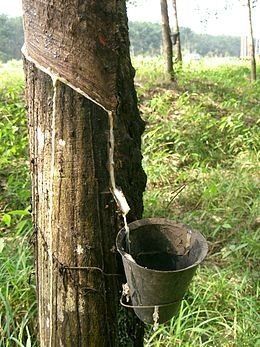As illogical as it may sound at first, the use of synthetic latex instead of vulcanized natural rubber sends a much more positive signal in terms of sustainability.
Advertising likes to refer to the biodegradability or compostability of natural latex, however, this is only correct if the natural rubber has not
been vulcanised.
However, a vulcanisation process is absolutely necessary in order for natural rubber to acquire the required elastic properties, which enable many technical applications. During the natural rubber vulcanisation process, synthetic vulcanisation additives and possibly antioxidants (age-resisters) are added. As a result of these admixtures, the modified natural rubber is no longer a pure natural product and its biodegradability is questionable.
Latex History

Bild: Tapping latex from a rubber tree
From the first use of natural rubber to the discovery of synthetic latex
The origin of latex reaches back to the milky sap of the rubber tree. The natural rubber obtained from it was already used in many ways in Central America in 1600 BC. Following the discovery of America by the Europeans, the raw material was gradually used to develop new products. The eraser was produced in 1770, the first raincoat in 1824, followed by waterproof rubber boots (Wellington boots).
In 1839, Charles Goodyear invented the vulcanisation process, with which the plastic natural rubber can be converted into elastic rubber. This provided many new possible applications, for example, the production of car tyres, which triggered a real natural rubber boom in Brazil.

Photo:Charles Goodyear, in Scientific American Supplement No. 787, 31 January 1891
After natural rubber in the form of rubber had become an industrially important material, attempts were made to grow rubber trees in plantations. This was unsuccessful in South America, as a special fungus prevented this. However, the English were able to develop plantations in their colonies in Asia. The additional plantations outside Brazil enabled better cover of the demand for rubber, so that the price fell and the rubber boom in the Amazon Basin came to an end. Today the five most important producing countries of natural rubber are Thailand, Indonesia, Malaysia, India and China.
(Source: Wikipedia 03/12)

Map: Rubber productionarte
During the First and Second World War the German Empire lost access to its natural rubber sources, which is why the search for alternatives was encouraged. The first synthetic latex was produced during the period of World War I. The production method was continuously improved during the following decades. It was possible to keep the positive natural properties while eliminating the negative properties of natural rubber. The result is that synthetic latex
has now completely replaced the use of natural rubber in many applications.



